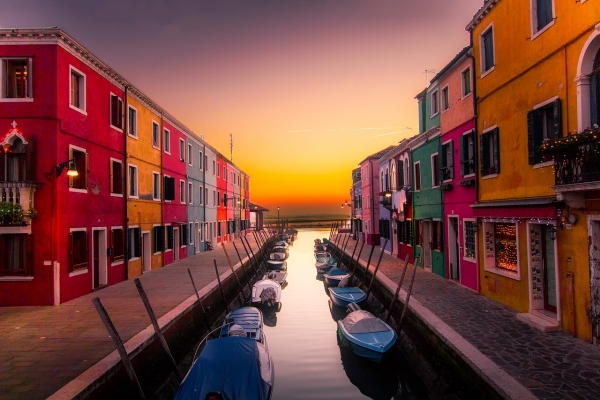Venetian cuisine has its own peculiarity: unlike what happens with some dishes of other regions, the gastronomy of Veneto can be tasted only on site, thus granting an extraordinary uniqueness and genuineness.
Venetian cuisine has a strong regional base, inheritance of the Serenissima (as the Republic defined itself) and its government, which encouraged the exchange and circulation of food products within the Republic: in this sense it is more correct to speak of the Venetian cuisine as the cuisine of the region of Venice, i.e. Veneto.
Venetian cuisine is based on delicate but very varied flavors, which find their roots in the history and the geographic conformation of the region. The basic products of most dishes are rice, polenta, baccalà and beans.
Rice comes from the Arab regions, with which the Republic of Venice was in close commercial contact; its cultivation begun in the 16th century in the plains of Verona.
Polenta is a mixture of corn flour and water, and it is curious to note that the plant was imposed to farmers by the government of the Republic in the 16th century, because they were reluctant to cultivate it. Even in other regions such as Lombardy, the cultivation of corn was introduced only after the plague of 1600, to stem the damages caused by famine.
Beans begun to spread at the same time as corn and later became very important in the Venetian cuisine, also for their protein content.
>Finally, “baccalà” (as dried stockfish is called in Veneto) comes from the northern seas and was introduced even later. The "discovery" of cod is due to the Venetian Captain Pietro Querini who in 1432 crashed on the island of Røst, in Norway; from there he imported the stockfish (not salted cod fish dried by the cold air of northern Europe on wooden trellises), which represented an excellent alternative to fresh fish, since it can be stored for a long time (even a few years) without altering. Baccalà is served on Venetian tables all year round as starter, first course or second course, accompanied by sauces, creams or even polenta.
The only really typical pasta is bigoli, whose preparation is historically linked to the work of the man rather than the housewife, for the physical strength required in the original preparation at home. Bigoli are a kind of thick spaghetti made using a press, whose surface is particularly rough and suitable to retain sauces.
Venetian cuisine is also known for mixing poor ingredients from the sea and from the earth. Symbol of this trend is perhaps its most famous dish, namely “Sarde in saor”, whose origin dates back to the ancient times during which Venice was trading with the East, a city of ships and sailors who had to cook dishes for long journeys.
The fact that Venice was an important maritime Republic explains the success of spices, widely used in the kitchen also as food preservatives: pepper and cinnamon, but also cloves and raisins, are an integral part of many dishes.
The stars of Venetian cuisine: asparagus and radicchio
In spring, the undisputed star of the Venetian cuisine is the white asparagus of Bassano, which is harvested when it has not yet sprouted from the ground, and is characterized by a bitter-sweet taste and an exceptional softness.
Asparagus is proposed in various preparations: with rice (“Risotto coi sparasi”), in lasagna or in the most typical recipe, "Ovi e sparasi" (eggs and asparagus), which I personally love: in this case the asparagus is boiled in special high and narrow pots with a basket, which allow you to keep the asparagus standing, to boil the stalks in water and steam the tips (which remain out of the water). The asparagus is then served with a simple sauce of boiled eggs, olive oil, salt and pepper. It can be a tantalizing appetizer, but more often a single dish.
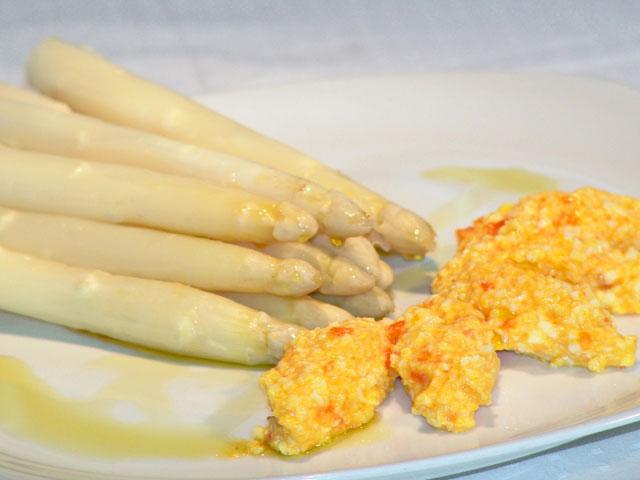
Another great protagonist of the Venetian cuisine is “Radicchio di Treviso” (i.e. from the area of Treviso, north of Venice), a dark red radicchio with white striations, a crunchy consistency and a delicately bitter taste. Radicchio di Treviso can be found in two variants: the “precocious” one, with a sweeter and more rounded taste, harvested around the middle of September, and the “late” one, more precious and more bitter, collected from mid-November to mid-December.
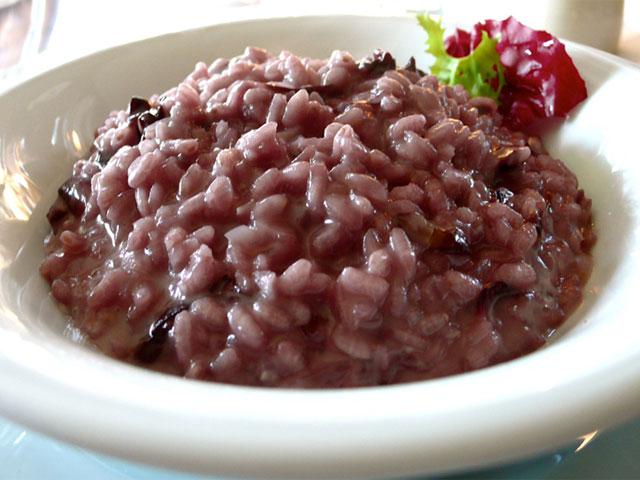
Radicchio di Treviso is an excellent ingredient for the preparation of Risotto (Risotto con Radicchio) and pasta, for example in combination with sausage.
Personally I love grilled “late” Radicchio, seasoned only with a little salt and raw oil.
La Polenta
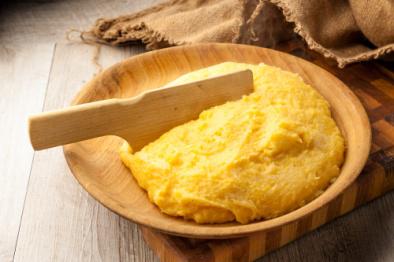
Polenta is one of the most ancient foods we know; it has always been on the tables of the poor as it has always been cheap, thus accessible to everybody. It is one of the symbolic dishes of the Venetian cuisine, being served with meat and fish, in liquid or sliced form after it has solidified.
The polenta flour is usually ground more or less finely, depending on the tradition of the region of production. It is poured in a cauldron (traditionally made of copper) full of boiling salted water, and it is continuously stirred with a stick of hazel wood, called "cannella", for at least an hour.
Appetizers
Starters play a fundamental role in Venetian cuisine. The counters of the "bacari" (taverns) are always full of "cicchetti", the typical Venetian antipasti to be tasted with an "ombra" (shadow, or glass) of good wine at the right temperature. Typical “cicchetti” include half eggs with anchovies, “soppressa” (cured meat) with polenta, fried crab claws, fried vegetables, octopus with polenta, crab meatballs.
My advice? Spend an evening in a Bacaro, tasting them just like a true local.
Baccalà
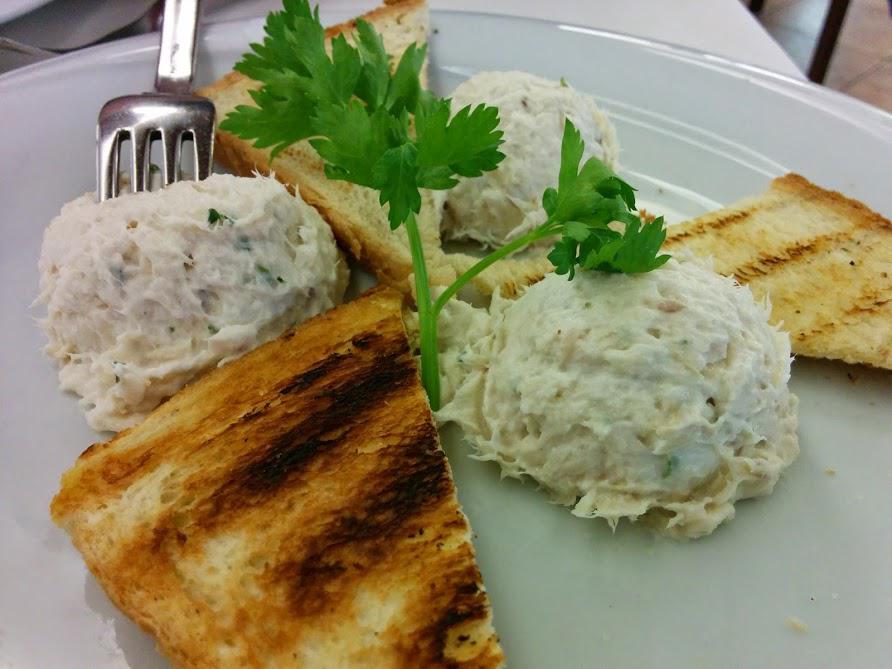
You should know that "baccalà" is the name the Venetians give to stockfish.
Stockfish is cooked in many different ways, but the most famous version (also my favourite) is the creamy one, “baccalà mantecato”. The fish is cooked in milk and then blended to make it very creamy. According to the original recipe, only olive oil, salt, pepper, garlic, bay leaves and lemon are used in its preparation.
I suggest you to taste it on a bread crouton, as it is often served in Venetian bacari.
Sardee “in saor”
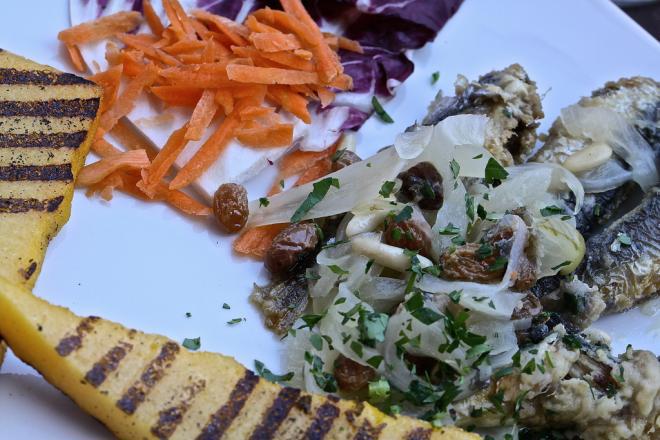
The Venetian starter par excellence is "Sardee in saor": sardines are fried and then marinated ("in saor") with vinegar and onion for a couple of days; later, they are flavored with pine nuts and raisins.
This particular condiment allowed to preserve the fish for a longer time, and for this reason “Sardee in saor” was one of the most common dishes of the fishermen of the lagoon, who needed to keep food in boats for several days.
Needless to say, the taste, strong and decisive, is truly unparalleled. Being vinegar one of the main ingredients, taste may seem a bit “strong”, but the sweet of onions and raisins and the crunchiness of pine nut help to balance it all.
Granseola alla veneziana
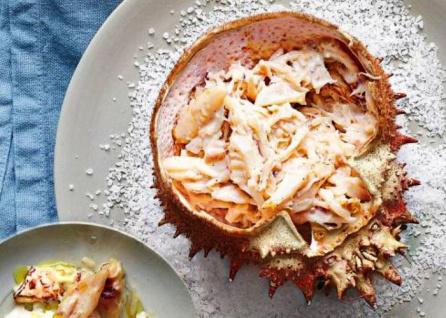
The “granseola”, or spider crab, is one of the finest and most refined appetizers in Venice. The crab is rather ugly and lumpy before cooking, but it changes appearance when served, with its bright red shell overturned and filled with its precious pulp and its corals.
The granseola is boiled, adding salt, lemon and pepper; once cooked, it is served with a drizzle of olive oil. Expensive, I must tell you, but extremely good.
First courses
Risi e bisi
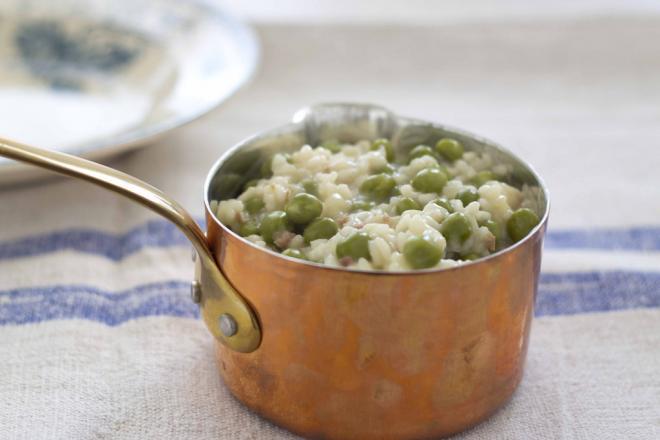
Traditional “Risi e Bisi” (rice and peas), a dish in the middle between a risotto and a soup, is prepared with rice grown in various areas of the region and with peas from Lumignano, a small village in the heart of the Berici Hills, where a particularly tasty variety is grown.
This very simple dish is perhaps the most traditional of Venetian gastronomy. Just think that during the holidays, and especially on April 25th, St. Mark’s Day, the Doge used to greet people looking out from the balcony of Palazzo Ducale with a dish of “Risi e Bisi” in his hand, as a sign of good omen!
Bigoli in salsa
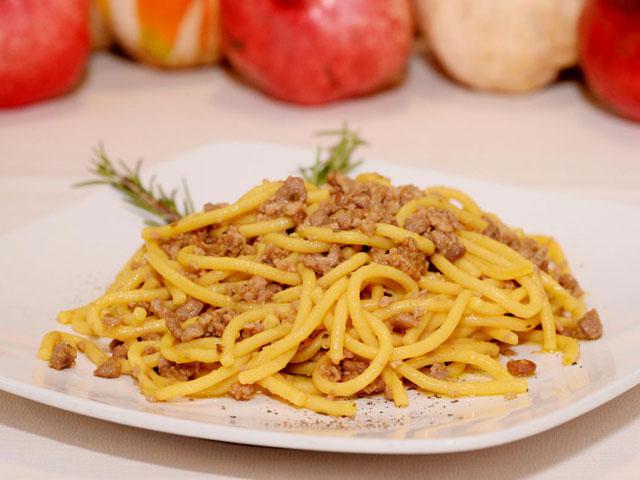
The most traditional format of pasta in Veneto is bigoli, a fresh pasta made using presses that were originally hand-operated. Bigoli retain sauces and condiments very well and are often offered with a meat sauce, a duck-based sauce in traditional "bigoi co l'arna", or an anchovy sauce, one of my favorites, based of onion and anchovies (onions in Venice, as you will realize, are a must).
Lasagnette con nero di seppia
Don’t be fooled by the name, the term "lasagnette" does not indicate the well known “lasagna”, but a sort of tagliatelle which today, however, have been converted into normal spaghetti and seasoned with the black ink of the cuttlefish.
Scampi in busera (con spaghetti)
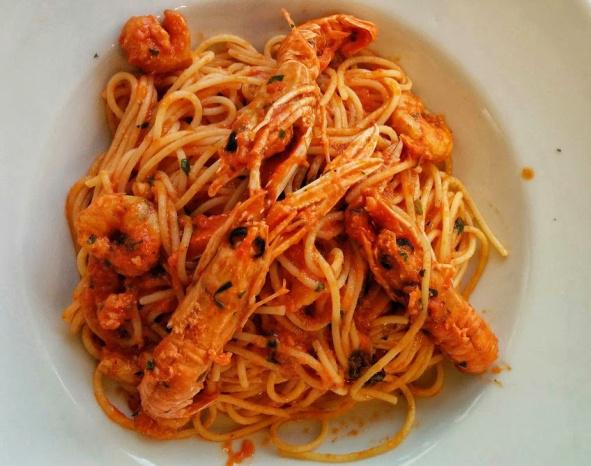
One of my favorite dishes. The "busera" was a pot used to prepare dishes on fishing boats. It basically consists of a plate of spaghetti with shrimps, covered by a fresh tomato sauce. Better if you add a little chili too.
Pasta e fasoi
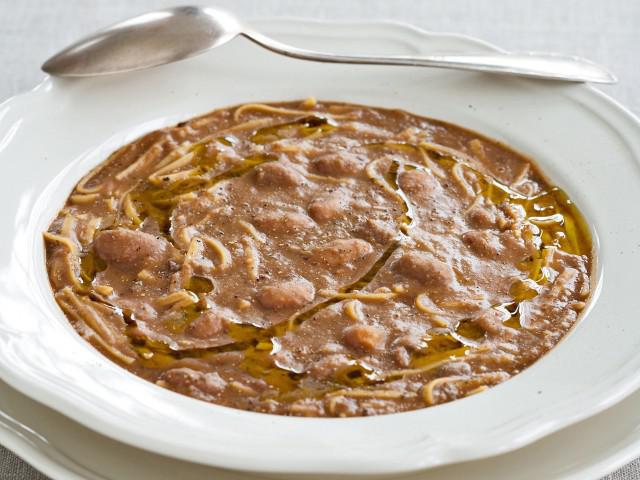
Pasta and beans is a very popular dish, offered by both classy restaurants and taverns, which here enjoys particular "veneration".
Pasta and beans was a poor and very nutritious winter dish, well appreciated by every social class. It is prepared with beans cooked and passed through a sieve, to which you add tagliatelle; it is served with a piece of lard, pepper, grated parmesan and raw olive oil. It’s not light but definitely tasty and enjoyable, a dish to be eaten preferably in cold months.
Among other dishes, I recommend tasting traditional risottos, especially those with red Radicchio di Treviso or Amarone della Valpolicella, the most famous and important wine of the region.
Another high quality product is the black truffle of the Berici Hills which, although not one of the finest truffles you may find around Italy, is excellent in risotto or in combination with fresh pasta such as tagliolini or tagliatelle, seasoned with butter to enhance the flavor.
Second courses
Moleche fritte and Moleche col pien
The preparation of “moleche” (green crabs during their moulting phase), is perhaps a bit cruel, since they must be alive for both preparations. In the second recipe, “Moleche col pien”, crabs are fried and stuffed with egg (they feed crabs with it before cooking). The peculiarity lies in the age of the crabs, which are cooked when they reach the peak of the moulting phase (before the armor has grown once again), and whose consistency is therefore softer than usual. The fishermen have a hard job, as this moulting phase lasts a few hours: they have very little time to extract them from the brackish waters of the lagoon.
Polenta e schie
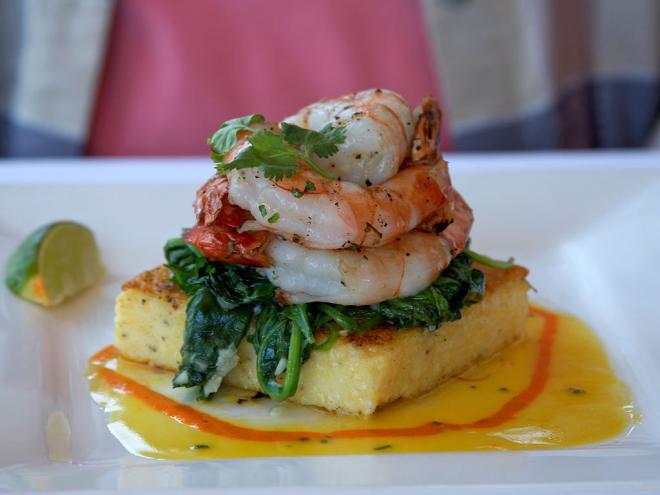
In this dish, typical of a “poor” cuisine, polenta is served with “schie”, small gray lagoon shrimps. “Schie” are boiled with water, lemon, garlic, pepper and salt and, once ready, are served on a bed of polenta. Venetians say that to fully enjoy this dish you have to eat it strictly with your hands!
Baccalà alla vicentina
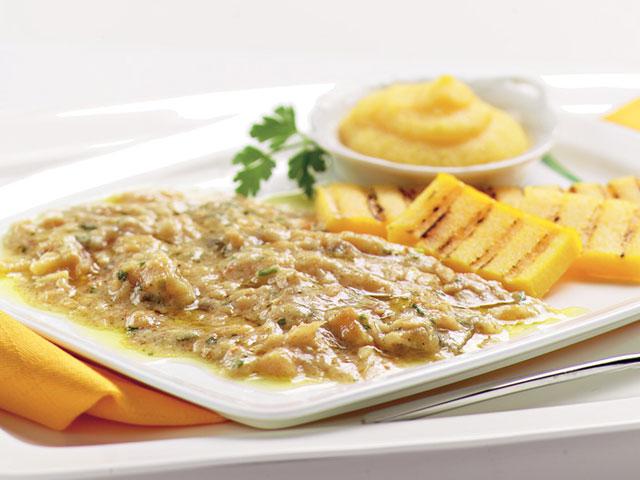
The most famous and celebrated dish of the Venetian cuisine is probably the cod, Vicenza-style. Its typical recipe is safeguarded by the “Venerabile Confraternita del Baccalà”, a fraternity based in Sandrigo, a town a few kilometers north of Vicenza, whose main task is to preserve the original ways of preparing this traditional dish.
Baccalà alla Vicentina is prepared by soaking the stockfish for a few days; once rehydrated and cleaned, the fish is floured and slowly cooked with onions, milk and olive oil, and finally served with polenta.
Baccalà is normally eaten as a single dish, or more rarely used for the preparation of risotto or with croutons as an appetizer.
Fegato alla veneziana
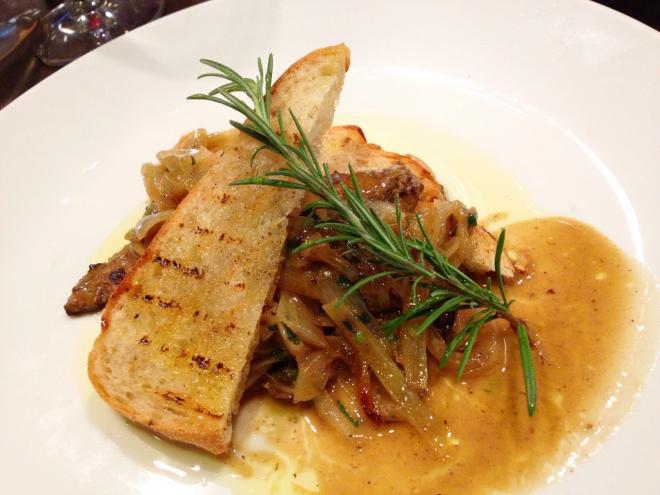
Liver “alla Veneziana” is known everywhere as a dish of the Serenissima. Its origins date back to the Roman era: in those times they used to cook liver (at the time especially of goose and pork, now strictly of veal) with figs, to mitigate the strong smell of meat. Venetians then replaced figs with the white onion form Chioggia, more common in the lagoon.
It is not a dish that I love, personally, but many are very fond of it. Basically veal liver is cut into very thin slices and cooked with onions (could they ever be missing?), parsley, olive oil, salt and pepper.
Other meat dishes
Poultry animals are very popular in Veneto, in particular the hen, the guinea fowl, the rabbit, the goose and the duck.
The hen from Padua, characterized by the great feathery tuft, boiled or stewed and accompanied by polenta, is particularly prized and tasty, Goose is also very popular, cooked in the oven, on a spit, used for the production of sauces and sausages (goose ham) or for traditional dishes such as “Oca in onto” (i.e. cooked in its own fat).
You will not miss local cured meats such as “Luganega”, a sausage made with minced pork and flavored with salt, pepper and herbs, which is generally grilled, and “Coeghin”, a sausage made with pigskin and ground and spicy pig muscles, boiled over a low flame for several hours and served in slices, generally accompanied with cooked radicchio or mashed potatoes.
Desserts

Among the typical sweets try “Zaletti”, rustic biscuits made with yellow corn flour, sugar and raisins, “Pandoro di Verona”, a Christmas cake now exported all over the world, and “Fugassa”, a soft and light sweet focaccia prepared with eggs, honey, almonds, and glazed with grains of sugar, which in the Easter period is made in the shape of a dove.>
And to end a good meal in line with the gastronomic tradition of Venice you cannot miss the “Fritole”, the typical fritters of Venice, inevitable in Carnival time. These candies were born in the Renaissance period and in 1700 became the national dessert of the Venetian Republic! You can taste them simple, that is only with raisins, or stuffed with cream.
Wines from Veneto
To fully enjoy the flavors of the Venetian table, dishes must always be accompanied by the excellent local wines, enhancing the qualities of both first and second courses.
The most famous red wines of Veneto are produced in Valpolicella and among these the most representative is certainly Amarone. This wine - rich, complex and powerful - is produced with dried grapes that after vinification result in a powerful and concentrated wine. Also famous is the technique of “Ripasso” used to make the Valpolicella reds more robust and full-bodied: red wine is poured (“ripassato”) onto the marcs of Amarone, thus giving the wine a stronger flavor and structure.
As to white wines, the most important is undoubtedly Soave Classico, a dry white, straw-yellow color, sometimes tending to greenish, with an intense and delicate aroma, produced with Garganega grapes.
Finally, Veneto is the home of Prosecco di Valdobbiadene, produced in the hilly area of the province of Treviso. It is a straw-yellow sparkling wine with a fruity scent (in particular the most typical hint of pear), produced with the Charmat method, currently enjoying extraordinary commercial success in Italy and abroad. Prosecco is available in different types: Dry, Brut or Extra Dry, based on the concentration of residual sugar left over after fermentation.
At the end of the meal you cannot miss a small glass of Bassano grappa. For those who want to end with something fresh, you must absolutely taste "sgroppino", a lemon sorbet washed down with prosecco.
Did I make your mouth water? Well, I’ll see you in Venice then.
